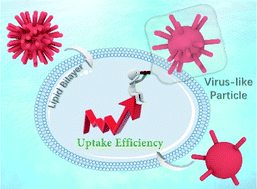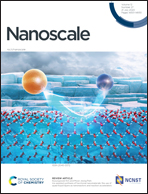Why synthetic virus-like nanoparticles can achieve higher cellular uptake efficiency?†
Abstract
Experimental studies in recent years have demonstrated that the cellular uptake properties of nanoparticles can be improved by mimicking the spiky surfaces of viruses; however, little is known on how the surface topological structure of nanoparticles affects their translocation across the cell membrane. Here, by employing dissipative particle dynamics simulations, the interactions between virus-like nanoparticles (VLPs) and the lipid bilayer are investigated. The analysis of critical force for penetration demonstrates that VLPs with relatively longer and sparser spikes have better penetrability. The internalization pathway of VLPs illustrates that the spikes of VLPs can perturb the bilayer structure after VLPs adhere onto the bilayer. Furthermore, by comparing the translocation process of VLPs and spherical nanoparticles, it is found that the presence of spikes can help to increase the lateral defects in the bilayer, decrease the vertical deformation of the bilayer, and lower the density of nearby lipids during the translocation process. These effects of spikes jointly contribute to the superior penetrability of VLPs. It is expected that these findings not only enrich our understanding of how the surface topological structure affects the cellular uptake, but also pave the way for further development of VLPs for versatile biomedical applications.



 Please wait while we load your content...
Please wait while we load your content...